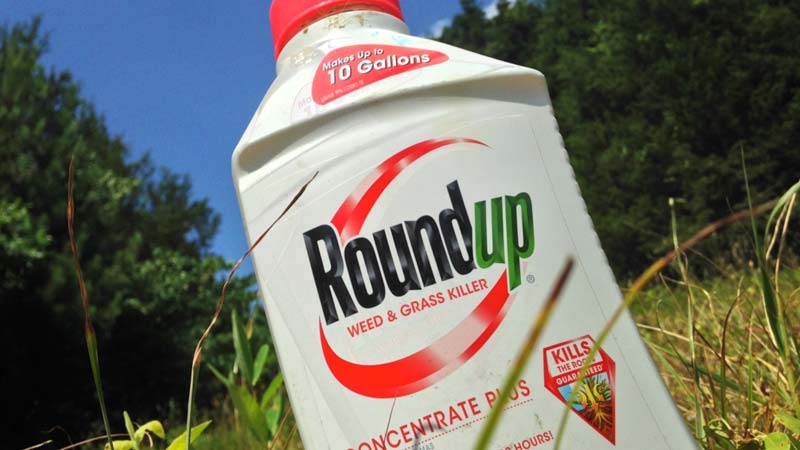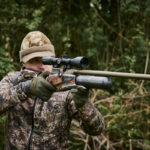1.2K
With so deer hunters many reaching for a bottle of herbicide to “improve” their food plots, are you truly helping your deer herd?
Food plotting has evolved greatly since the days of an “ol’ greenfield.” From Genetically Modified Organisms (GMOs) to precision farm equipment, today’s food plots are comparable to most commercial farming operations. Though heavily used in food plots, herbicides are likely the least understood by those applying them. So are you actually benefitting your food plots and deer by using these chemicals?

Table of Contents
Glyphosate (AKA Roundup®)
Likely the most utilized herbicide for food plots, glyphosate or more commonly called by its trade name Roundup®, is one that is used in both food plot preparation, as well as weed and grass control in actively growing plots. Though it is one of the most commonly used herbicides, it is likely one that is least understood.
For instance, many worry about how glyphosate can affect seeds just planted or how long to wait before planting after spraying glyphosate. The answer is simple, you don’t have to wait at all. Glyphosate is a foliar-active herbicide meaning that it typically travels through the leaves of the plant to the roots to kill. So when there are no parts of the plant exposed (as is the case with seeds) then there is no possibility of killing the plant. The only benefit of waiting is to allow competition in the immediate vicinity to die back so the new plant has access to more available nutrients. In this case, it will take approximately 7-10 to start seeing significant results.
USAGE
Most glyphosate products will range in application rate. Typically this is determined by the type of plants you are trying to remove and at what growth stage. For instance, removing something like common ragweed, an annual broadleaf weed, may need 16oz/acre. But a hardy, perennial grass-like fescue could require up to 64oz/acre.
Typical herbicide application requires it to be mixed with water to create a “solution.” The amount of solution applied per acre depends on the application method. For example, if you are using a tractor and 3-point sprayer with 25-foot boom arms, then based on the tractor speed, sprayer pressure, and the number of nozzles, you will determine the amount of solution per acre. This is called “calibrating” the sprayer. Why is this important? Well let’s say your sprayer puts out 15 gallons of solution per acre, and you are wanting to apply 64oz of glyphosate per acre to kill fescue. Then you will need to add 14.5 gallons of water (15 gallons of “solution” less 64oz of glyphosate) for every 64oz of glyphosate to adequately treat an acre.
Calibrating a sprayer ensures that you are killing the plants you want, and at the same time not negatively affecting the crops you want to grow. Too much glyphosate can dramatically reduce yields in crops (like “yellow flash” in soybeans, corn, alfalfa, or wheat) or worse, kill the plants you were trying to release from the competition. Not enough glyphosate applied wastes your time and money, by not effectively removing the weeds and grasses resulting in continued competition and a drop in yield. So as you can see there is a lot more to spraying than just “running and gunning.”
BENEFITS
There is a limited amount of nutrients (Nitrogen, Phosphorus, Potassium, Calcium, etc.) and resources (like water moisture) in the soil available to plants. By removing the competition, we are essentially allowing the plants we want access to more of the requirements needed for optimum growth. More available nutrients in the plant mean more nutrients transferred to your deer during normal grazing behavior.
Glyphosate shows benefits in both food plot preparation and maintenance. Most areas are crowded with undesirable plant species before being planted. You have options, mow it down, till it under, or even both. But typically this only removes the visible vegetation and does not kill the plant. Often, several weeks after planting weeds and grasses will erupt in the plot, sucking valuable nutrients from the crop you are growing. Spraying glyphosate prior to planting, will kill all existing plants and dramatically reduce the number of weeds and grasses that come up after planting.
With the advent of GMO species like “Roundup® Ready” or glyphosate-resistant soybeans, corn, alfalfa, and wheat, glyphosate can be sprayed on actively growing plots to remove any competition and not significantly affect the planted crop. It is worth noting that anytime a crop is sprayed with glyphosate, even at the correct rate, the herbicide will tie up nutrients in the soil, essentially “handcuffing” the plant from taking up critical resources. Though it is a negative, the benefits of releasing it from competing vegetation are typically greater. There are also new products for food plotters and farmers on the market to counter glyphosate’s “handcuff” effect.
HARMFUL EFFECTS ON WILDLIFE
Even though we know that using glyphosate appropriately can effectively reduce competition, and result in increased nutrients to the crops we are promoting, we are still applying a chemical. In school, we are often taught that chemicals are “bad.” In fact, when we hear chemicals often the old skull and crossbones seem to be the first image to appear in our heads. So with that being said, can using glyphosate on food plots hurt the deer we are intending to help?
In 2010, nearly 70% of all corn and 93% of all soybeans were herbicide-resistant. With that many acres being planted, and whitetails occupying a lot of it, any negative effects would likely have made national news. Studies reported by the U.S. Environmental Protection Agency (EPA) revealed glyphosate “…is practically non-toxic to upland game species.” Other studies have focused on the effects on upland game birds like bobwhite quail, and waterfowl, like mallard ducks. With a large amount of glyphosate needed to be directly ingested, it is a “slight” toxic risk at most to even these small animals. So the odds of any type of negative anatomical effect on an animal the size of a white-tailed deer is highly unlikely. This is also demonstrated in Table 1, which shows active ingredients in herbicides, as well as commonly known items and their “LD50” values. An LD50 value represents the dose of a specific chemical needed to kill half of the tested population (usually mice or rats). At over 5,000 mg/kg for oral ingestion, glyphosate is nearly 25 times less toxic than the bleach in your laundry room! Yes, chemicals can be dangerous; and should always be treated carefully, with proper safety gear, and according to the label recommendations. But many things already in your home are much worse!
Sethoxydim and Clethodim (AKA Poast®, Select®, Arrest®)
In the majority of food plots, the most competing vegetation is grasses. From Fescue to Bermuda to Foxtail, grasses can choke out what seemed to be a healthy food plot in no time. Because of the thick, extensive root system of grasses, they are easily able to outcompete many food plot species for valuable nutrients, micronutrients, and water. Fortunately, we do have options to free our food plots from grasses’ “death grip” and thrive to provide for whitetails. Sethoxydim and clethodim are herbicides that control annual and perennial grasses in broad-leafed food plots like clover, chicory, alfalfa, brassica, and even soybeans. But they aren’t for all food plots, and deer hunters can run into some issues when treating “mixes.”
USAGE
The most commonly used sethoxydim goes under the trade name Poast®, and the most common clethodim is a trade named Select®. Both can control annual and perennial grasses. Typically, it is a personal preference of which to use, though some may say one herbicide is better on a specific grass than another. For example, some fescues are more effectively controlled with clethodim than sethoxydim. Regardless of which you choose, it is important to pair them with crop oil or surfactant. This will help the herbicide penetrate the leaf tissue more effectively and allow the herbicide to move through the plant. Typically, results begin to show around 10-14 days of application. Application rates vary based on the grasses targeted and the stage of growth but range from 8-32 ounces. The chemicals can be applied with a hand pump, backpack, ATV/UTV, or tractor-mounted sprayers.
As previously mentioned, these herbicides can provide plenty of “relief” for clover, brassica, and many other types of broadleaf food plot species. However, though we may not think of them as “grasses,” sethoxydim and clethodim will kill wheat, oats, rye grain, and even corn. Where this particularly causes a problem for food plotters is when planting “mixes.” A “mix” is planted to provide forages that peak in attractiveness and/or nutrition throughout the year. For instance, you might plant a mix of oats and brassicas, where the oats will be attractive early in the hunting season and the brassicas attractive during the late season. If the grass becomes an issue in this plot, spraying sethoxydim or clethodim will not only remove the grasses but your oats as well! Be very careful when deciding whether or not to spray a food plot that contains a mix of species.
BENEFITS
Food plots released from grass competition will be able to uptake more nutrients, micronutrients, and water, often resulting in better growth and more nutrients which will be passed on to grazing deer. Sethoxydim and clethodim really “earn their keep” when it comes to maintaining perennial food plots. These year-round, nutritionally-packed food plots are susceptible to grasses during the new growth cycle every spring and summer, especially as they age. Spraying the grass-selective herbicides during the late spring or early summer can release the perennial plots from competing grasses and allow them to obtain the critical nutrients needed to provide your deer herd with a source of highly-digestible protein during late pregnancy, early fawn development, and antler growth.
HARMFUL EFFECTS ON WILDLIFE
Unlike glyphosate, there has not been as much testing of the grass-selective herbicides sethoxydim and clethodim on wildlife. As much as it seems non-related, the best testing we can point to is that of the domesticated sheep, which like white-tailed deer are ruminants (having a four-chambered stomach). Research published by the EPA noted that clethodim residue was “adequately delineated” in testing on sheep. In other words, the clethodim residue was displaced into the proper regions of the body through filtering or excreted with no signs of negative effects. In fact, when testing was conducted on dogs, 91% of the ingested clethodim residue was found in the urine and feces. What does this mean? Basically, less than 10% of the chemical actually ended up in the body, and such a low dose resulted in no adverse effects on the animal. Keep in mind that these tests were done by giving animals a “straight dose” of the chemical through a gel pill, rather than wildlife naturally browsing through a treated field which is likely resulting in much less herbicide being ingested.
2, 4-D and 2, 4-DB (AKA P.B.I.®, Hi-Yield®, Butyrac®)
Though typically not as competitive as grasses, broadleaf weeds can be a problem in food plots, especially when disturb-favored weeds erupt not long after tilling the soil. The herbicides, 2, 4-D and 2, 4-DB, control broadleaf plants in food plots. But unlike sethoxydim and clethodim, these two chemicals are dramatically different in the manner they can be used.
USAGE
The two herbicides both can effectively control broadleaf weeds, however, the effect on the food plot species planted is drastically different. If you apply 2, 4-D on a clover or alfalfa plot, not only will you eliminate broadleaf weeds but also your entire food plot! This herbicide is more suited for removing broadleaf weeds out of grass-like plots including oats, wheat, and corn. So what do you do for clover and alfalfa plots?
That’s why the “B” in 2, 4-DB is so critical. Representing butyric acid, 2, 4-DB allows the control of broadleaf in clover and other legumes. This is extremely valuable in mixes as mentioned earlier. If a food plot contains oats, wheat, and clover, a plotter could spray with 2, 4-DB to control unwanted broadleaf weeds without negatively affecting the food plot species.
The two herbicides can be applied via any of the spray equipment previously mentioned. Rates vary, but often 16-32 ounces of herbicide per acre is required.
BENEFIT
Like grasses, broadleaf weeds can suck valuable resources from our food plots. By removing the competition, we are able to “free up” more components for our food plots to thrive, which are likely to end up in the deer we are trying to grow healthier and larger.
Broadleaf weeds are also capable of shading out food plots, which can stunt growth, or worse, kill food plot species. An alternative to spraying 2, 4-D or 2, 4-DB is the use of mechanical removal, typically through mowing. Because the broadleaf weeds are normally annuals, cutting them can allow the food plot species to “jump ahead” and never look back. It’s worth noting that the plant can still recover from mowing and come back during the same growing season, whereas, the chemical treatment will likely kill it off.
HARMFUL EFFECTS ON WILDLIFE
Research on the different forms of 2, 4-D has only shown effects on fish and some aquatic amphibians. Its effect on mammals appears to be nearly non-existent. However, because of its elevated LD50 value (see Table 1), it should be handled with utmost care. The only real issue documented has been severe eye irritation when in direct contact with the herbicides.
Herbicide use on food plots is likely only to increase. It’s important to understand what the chemical you are applying is, what it does, and if it can affect both animals and humans. The herbicides discussed are the most commonly used on food plots for deer. When used correctly, they can be a huge asset to any deer hunter looking to generate a plot better than their neighbor’s.











































